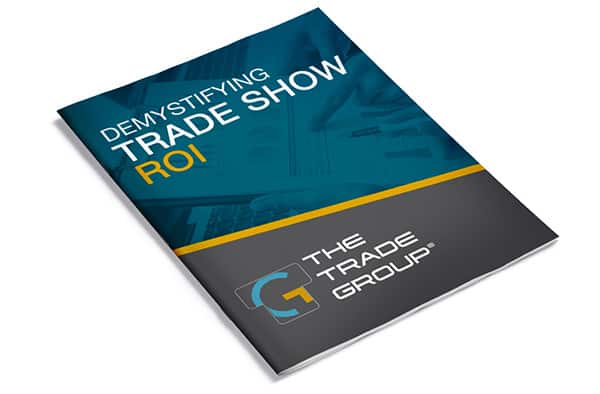
Read this in as dramatic a voice as you can muster:
“The House of Wax. The ultimate dimension in terror comes to the screen in stereo vision 3D. Vincent Price at his diabolical best will take you room by terrible room to the ultimate chamber of horrors. Stereo vision 3D will synthesize before your eyes the terrifying reality of it all. In stereo vision 3D: House of Wax.”
This short, punchy trailer debuted in theatres across the country in the winter of 1953. While the House of Wax isn’t the first 3D movie, it’s certainly the first to be publicized across the country.
The 3D movie is a small skirmish in a larger battle that’s still raging today. Did it work? Yes and no. And there are important lessons for trade show exhibitors when it comes to using exciting new technology in their trade show booth, whether it’s VR, AR or AI.
Hollywood’s war on television
Declining ticket sales.
Those three little words are enough to strike fear in the heart of any event organizer or stage manager. Sometimes the reason for a sudden slip in attendance is a mystery. Other times, it’s obvious. But the question that always follows is “how do we get people to come back?” — which is what Hollywood was asking after World War II.
The reason for Hollywood’s plummeting ticket sales is threefold: the invasion of television sets in household living rooms, blacklisting of actors, writers and directors during the Mcarthy Era and the abolishment of the studio system.
To get people back in theatres they tried several new technologies such as 3D, CinemaScope, and Cineorama. It appeared to work for a while, but not for long. At the end of the day, Hollywood was forced to throw in the hat and broadcast their movies into homes.

Technology, trends, and capturing your prospects’ attention
In our own age, beginning in the 2000s, streaming began to take the place of cable and broadcasting. Brick and mortar movie rental stores couldn’t compete. And for now, it seems as if theatres are in the same boat.
Theatres are still trying to find ways to bring in traffic and make money, though technology is playing a smaller role in their advertising. Today, theatres are relying on nostalgia and offering services like renting an entire theatre for a watch party, dining, and, more recently, charging different prices for seating.
So, what kind of lessons can trade show exhibitors learn from Hollywood’s war on television? For marketers looking to use audio/visual elements and immersive technology in their exhibit, consider these factors.
The technology that requires the least amount of effort is what your prospects are using
After the House of Wax premier, movie-goers exiting the theatre complained of headaches, eyestrain, and even nausea. Zoe Z. Dean writing for Looper, says that audiences thought 3D was worth the headaches. Ultimately, what did 3D movies in was not lack of interest but technical difficulties. When things went wrong, the audience were the losers.
The whole point of technology is creating faster systems and eliminating wasted time and energy to make our lives easier. Essential to this fact is that the tech has to be user-friendly. If you’re using a photobooth or VR headset that’s glitching, it won’t be long before a prospect will abandon the idea.
This is true no matter the tech. According to research conducted by Google, 53% of mobile website visitors will leave if a webpage doesn’t download in 3 seconds. When a product or experience is not easy to use, the pattern is the same: a prospect will slow down, get confused and frustrated, and then leave.
Gimmickry is not a long-term strategy
The House of Wax really kicked off the 3D golden age. Theatres were packed. The box office was raking it in. Unfortunately, the golden age only lasted from 1952 to 1955. Can we say this is a golden age or golden minute?
What counts as a gimmick? Merriam-Webster defines it as an Ingenius or novel device used to attract attention. Where gimmicks often fall short is in keeping people’s attention. For exhibitors, the lesson is that not all traffic is good traffic.
A full booth is only good if it’s full of target buyers. So then, the strategy for bringing people into a trade show booth should include all parts of the journey, from attracting to generating interest and desire to action.

Use technology to support the message
While 3D was a hit with most audiences, critics skewered many of the movies as bland with boring story lines. A common criticism was that it seems that 3D movies couldn’t be made without something being thrown at the audience. The spectacle of the technology distracted from other important aspects of the films.
New technology is great but remember that it’s a tool that supports the message of your product which is supposed to bring value to your customers/clients. The final takeaway is this: Narratives that resonate with your target audience are what wins them over.

The Trade Group is a full-service trade show and event marketing company. We will work with you to create an exhibit or an event that brings in leads and helps you achieve your business goals. Contact us here or give us a call at 972-734-8585.
Cameron Wilkinson is a writer and editor in Dallas, TX. His writing for the events industry pairs with his interests in sales and marketing. He also holds a B.A. in English Literature form the University of North Texas.
Photo Credit: Pexels



